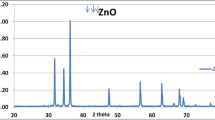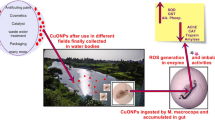Abstract
Development of nanomaterials and their use on an industrial scale have been booming over the last decade. Indeed, the physicochemical properties of these materials allow their use for various applications, ranging from the manufacture of food products or cosmetics, to the development of tools for electronics or the biomedical sciences. The aim of this work was to study the effects of CdSe on the general redox state of hepatopancreas of the snail Helix aspersa and to evaluate the effect of this nanomaterial on mitochondrial swelling and respiration. Our results show an increase in the activity of the antioxidant enzymes of mitochondria (GST, Catalase, MDA) and a decrease in GSH and GPx level in mitochondrial hepatopancreas. Thus, we showed an increase in mitochondrial swelling with a decrease in respiratory level. Finally, our study suggested that mitochondrial dysfunction and oxidative stress were high in the digestive gland of snails treated with 3.6 and 7.2 μg/g/2day.
Similar content being viewed by others
References
Bigorgne, E. Ecotoxicity of nanoparticles and by-products of alteration of titanium dioxide on the earthworm, Eisenia fetida. Doctorate thesis. Paul Verlaine-Metz University. P2 (2011).
Triboulet, S. Study of the effects of two types of metallic nanoparticles on murine macrophages by a proteomic approach. Doctorate thesis. Grenoble University. P:25 (2013).
Baratli, Y. Study of the toxicity of iron oxide nanoparticles (Fe3O4) in the rat, mitochondrial analyzes and oxidative stress. Doctoral thesis. University of Strasbourg and University of Carthage (2015).
McBride, H. M., Neuspiel, M. & Wasiak, S. Mitochondria: More Than Just a Powerhouse. Curr. Biol. 16, R551–R560 (2006).
Sbartai, I. et al. Behavior of Paramecium sp. treated with bifenazate with special emphasis on respiratory metabolism, protein and generation time. American-Eurasian J. Toxicol. Sci. 1, 13–18 (2009).
Benbouzid, H., Berrebbah, H., Berredjem, M. & Djebar, M. R. Toxic effects of phosphoramidate on Paramecium sp. With special emphasis on respiratory metabolism, growth, and generation time. Toxicol. & Environ. Chem. 94, 557–565 (2012).
Jasso-Chávez, R. et al. Toxic effects of Cr(VI) and Cr(III) on energy metabolism of heterotrophic Euglena gracilis. Aquat. Toxicol. 100, 329–338 (2010).
Boulassel, A. Evaluation of the toxicity of two drugs: Paracetamol and Ibuprofen, on a cellular model: Paramecium tetraurelia. Test on the subcellular scale. Doctorate thesis. Universite Badji Mokhtar de Annaba (2014).
Chagra, A., Djebar, M. R., Rouabhi, R. & Berrebbah, H. Cadmium Induced Changes in Metabolic Function of Mitochondrial Isolated from Potato Tissue (Solanum tuberosum L.). Am. J. Biochem. Biotechnol. 5, 35–39 (2009).
Ivanina, A. V., Habinck, E. & Sokolova, I. M. Differential sensitivity to cadmium of key mitochondrial enzymes in the eastern oyster, Crassostrea virginica Gmelin (Bivalvia: Ostreidae). Comparative Biochemistry and Physiology - C. Toxicol. Pharmacol. 148, 72–79 (2008).
Garceau, N., Pichaud, N. & Couture, P. Inhibition of goldfish mitochondrial metabolism by in vitro exposure to Cd, Cu and Ni. Aqua. Toxicol. 98, 107–112 (2010).
Wang, Y., Fang, J., Leonard, S. S. & Rao, K. M. K. Cadmium inhibits the electron transfer chain and induces reactive oxygen species. Free Radic. Biol. Med. 36, 1434–1443 (2004).
Acker, V., Koymans, L. M. H. & Bast, A. Molecular pharmacological importance of vitamin E, structural aspects of NADP. Free Radic. Biol. Med. 5, 311–328 (1993).
Canesi, L., Viarengo, A., Leonzio, C., Filippelli, M. & Gallo, G. Heavy metals and glutathione metabolism in mussel tissues. Aquat. Toxicol. 46, 67–76 (2010).
Phuong Nguyen, D. Thèse de doctorat. université Paris VI (2005).
Coeurdassier, M. et al. The garden snail (Helix aspersa) as bioindicator of organophosphorus exposure: effects of dimethoate on survival, growth and acetylcholinesterases activity. Environ. Toxicol. Chem. 20, 1951–1957 (2001).
Gomot, A. Effects of heavy metals on the development of snails. Use of snails as bio-indicators of heavy metal pollution for the preservation of human health. Bull. Acad. Natle. Medicine. 181, 59–75 (1997).
Bradford, M. A rapid and sensitive method for the quantities of microgram quantities of protein utilizing the principle of protein binding. Ana. Biochem. 72, 248–254 (1976).
Kristal, B. S., Park, B. K. & Yu, B. P. 4-hydroxynonénal est un puissant inducteur de la transition de perméabilité mitochondriale. J. Biol. Chem. 271, 6033–6038 (1996).
Rouabhi, R., Djebar, H. & Djebar, M. R. Toxicity evaluation of flucycloxuron and diflubenzuron on the cellular model, Paramecium sp. Afr. J. Biotechnol. 5, 045–048 (2006).
Rouabhi, R., Djebar, H. & Djebar, M. R. Toxic Effects of Combined Molecule from Novaluron and Diflubenzuron on Paramecium caudatum. Am-Euras. J. Toxicol. Sci. 1, 74–80 (2009).
Rouabhi, R., Djebar-Berrebbah, H. & Djebar, M. R. Toxic Effect of a Pesticide, Diflubenzuron on Freshwater Macroinvertebrate (Tetrahymena pyriformis). Chinese J. Appl. Environ. Biol. 12, 514–517 (2006).
Cakmak, I. & Horst, W. J. Effect of aluminum on lipid peroxidation, superoxide dismutase, catalase, and peroxidase activities in root tips of soybean (Glycine max). Physiol. Plantarum. 83, 463–468 (1991).
Habig, H., Pabst, M. J. & Jokoby, W. B. Glutathione-S-transferase: the first enzymatic step in mercapturic acid formation. J. Biol. Chem. 249, 7130–7139 (1974).
Weckbker, G. & Cory, J. G. Ribonucleotide reductase activity and growth of Glutathoine depleted mouse leukemia L1210 cells in vitro. Cancer Lett. 40, 257–264 (1988).
Esterbaer, H., Gebicki, J., Puhl, H. & Jungens, G. The role of lipid peroxidation and antioxidants in oxidative modification of LDL. Free Radic. Biol. Med. 13, 341 (1992).
Flohe, L. & Gunzler, W. A. Assays of glutathione peroxidase. Methods Enzymol. 105, 114–121 (1984).
Author information
Authors and Affiliations
Corresponding author
Rights and permissions
About this article
Cite this article
Salmi, A., Rouabhi, R., Toualbia, N. et al. Subcellular study of the cadmium selenide nanoparticles (CdSe-NPs) toxicity on a terrestrial bioindicator model Helix aspersa . Toxicol. Environ. Health Sci. 9, 135–140 (2017). https://doi.org/10.1007/s13530-017-0314-4
Received:
Revised:
Accepted:
Published:
Issue Date:
DOI: https://doi.org/10.1007/s13530-017-0314-4




